Learn About the Provider Data Model
Learning Objectives
After completing this unit, you’ll be able to:
- Explain the purpose of the Provider data model.
- Describe the objects for healthcare providers and healthcare facilities.
- Describe the objects for payer and facility networks.
- Describe the objects for healthcare provider specialties.
- Describe the objects for healthcare provider certification, education, and licenses.
The Provider Data Model
The Provider data model represents healthcare providers, including individual practitioners and facilities, the network they participate in, and their specialties and credentials.
Sara Johnson is a physical therapist who’s affiliated with the PT Health Specialists organization, which has multiple facilities. Sara works at the PT Health Specialists - Downtown branch from 9 AM until 5 PM on Mondays, Wednesdays, and Fridays. This branch is in the Bloomington Health Plans PPO network, which is the network for the PPO plan that Charles Green enrolled in.
Sara has a National Provider Identifier (NPI) number, a business license, and awards and credentials, including her American Board of Physical Therapy Specialties certification. She specializes in orthopedic physical therapy, which makes her a great choice for Charles’s lower back pain condition.
Healthcare Providers
When you model healthcare providers in Health Cloud, represent them as a person or an organization, and represent what they do.
The Account object with a Business record type represents providers that are organizations.
For people, use either person accounts or contacts, but we strongly recommend person accounts. Person accounts are a better fit for healthcare providers who are their own independent entity with practicing rights at a number of locations. These individuals have their own unique identification number, such as a National Provider Identifier (NPI), which follows them regardless of where they work. If you map individual providers as contacts, there are limited capabilities for these records.
The Healthcare Provider object represents what the providers do. This object stores business-level details about the healthcare organization or the individual, such as the provider type.
A healthcare provider record and person account combine to represent the FHIR Practitioner resource in Salesforce. The healthcare provider record is the base, and it references the person account record using the AccountId field.
If you model providers only as person accounts, you may not be able to use Health Cloud capabilities such as provider search. However, when you model providers using both the Healthcare Provider object and person accounts, then this ensures they’re aligned to the FHIR Practitioner resource and they can use provider search. To learn more, see Practitioner.
People
Sara Johnson is a physical therapist. Use the Account object with a Person record type for people.
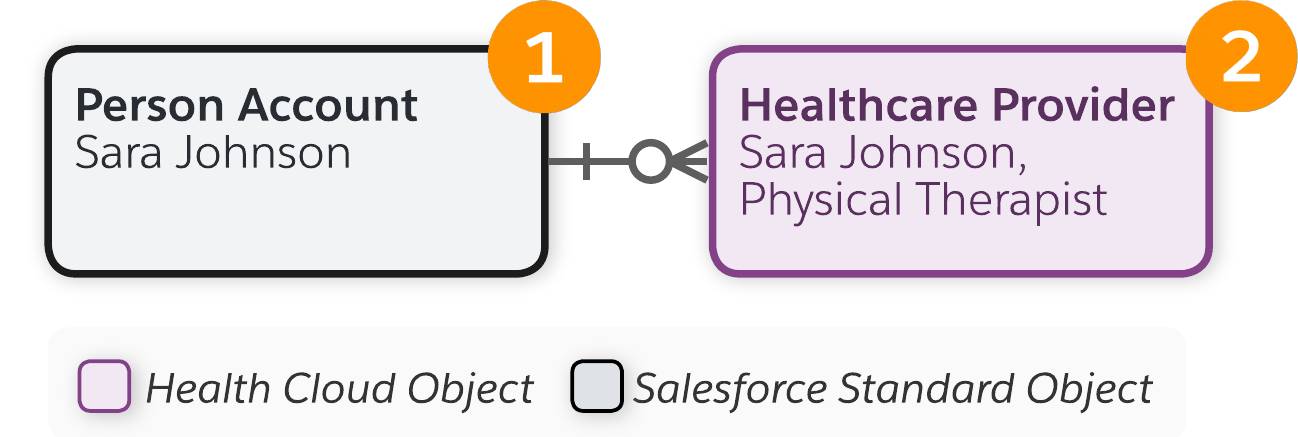
Sara’s person account record (1) represents Sara as a person and her healthcare provider record (2) represents her as a physical therapist.
In the UI, Sara’s healthcare provider record has an Account field that references her person account. Note that Sara’s person account record may have more than one related healthcare provider records, as Sara is one person but she may have multiple healthcare provider roles.
Organizations
PT Health Specialists is a healthcare organization that Sara is affiliated with. Use the Account object with a Business record type for organizations.
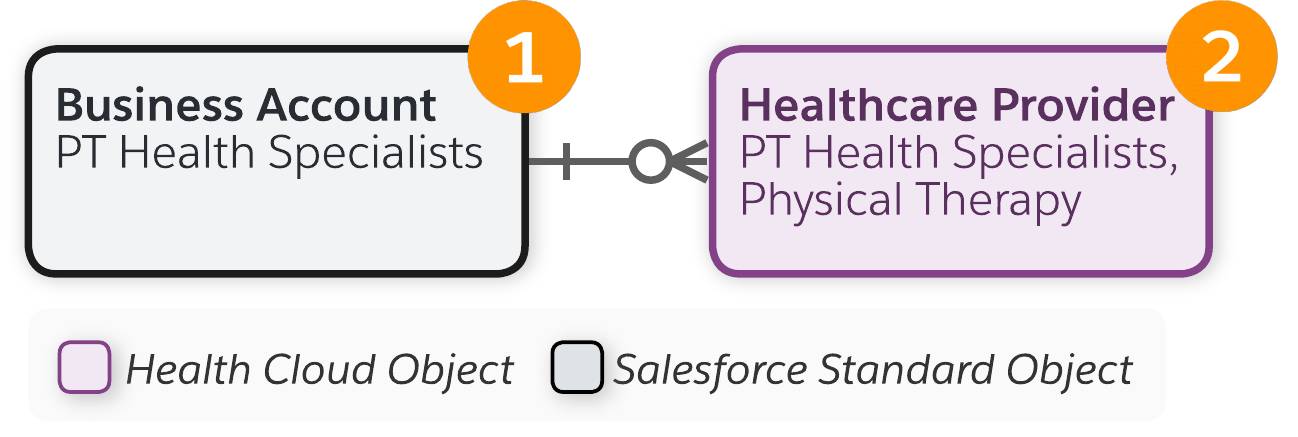
A business account record (1) represents PT Health Specialists as an organization and a healthcare provider record (2) represents what this organization does. In the UI, the healthcare provider record references the business account in the Account field.
The PT Health Specialists organization has multiple facilities. Let’s see the objects that represent them.
Healthcare Facilities and Facility Practitioners
Think of a healthcare facility as a building and a healthcare facility practitioner as a person who works in that building. The building has many people who work there, and a practitioner may work in more than one building. The next two objects cover these scenarios: Healthcare Facility and Healthcare Practitioner Facility.
Healthcare Facilities
The Healthcare Facility object represents a healthcare facility and its physical, functional, geographic, or business details. A healthcare organization’s local branches or facilities need healthcare facility records that reference a business account and a healthcare provider record for that specific branch or facility.
PT Health Specialists has a Downtown branch.
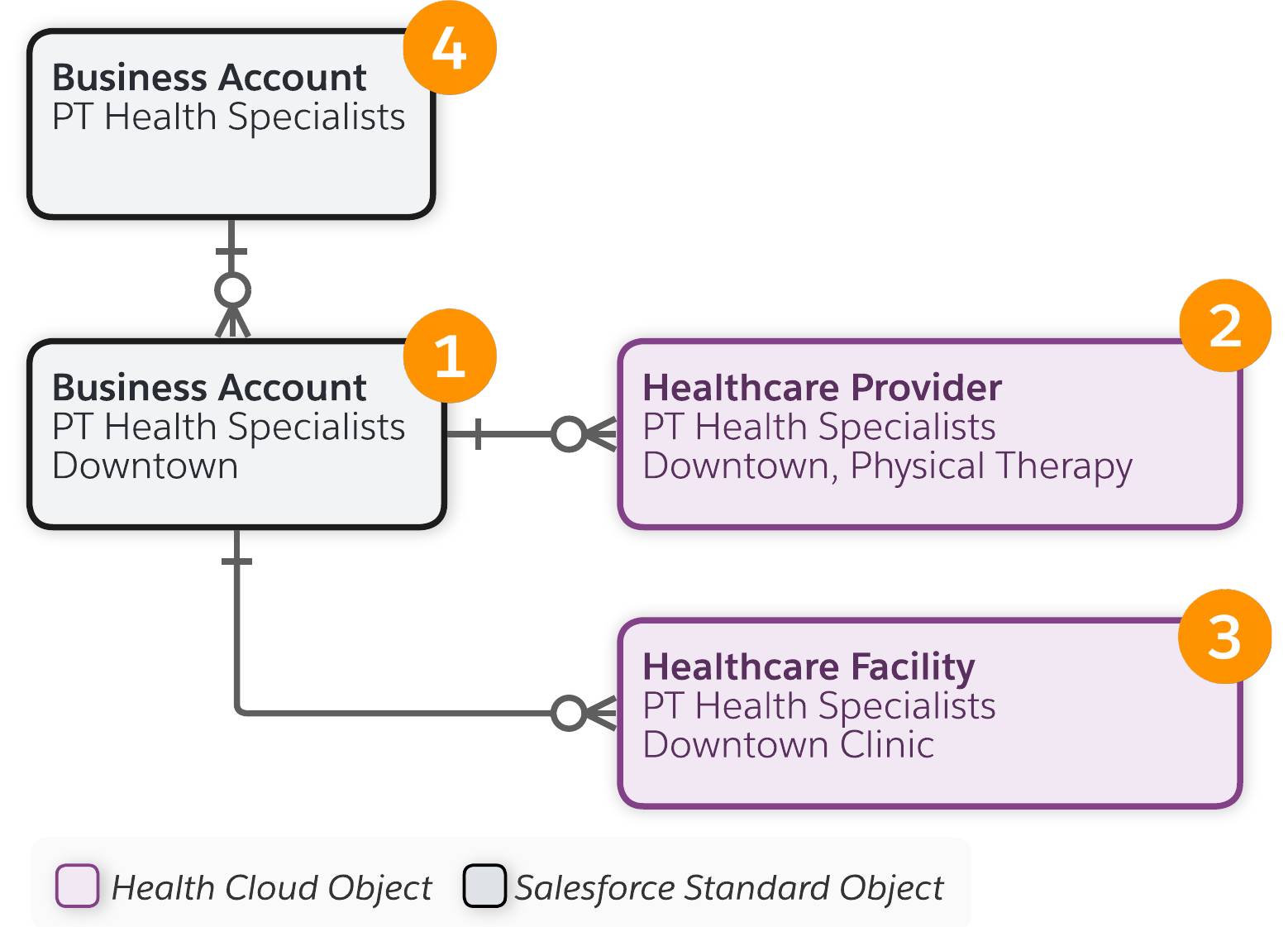
A business account record represents the PT Health Specialists Downtown branch (1). The business account record references:
- A healthcare provider record for PT Health Specialists Downtown (2)
- A healthcare facility record for PT Health Specialists Downtown (3)
- The business account record for the parent business account (4)
Next, let’s represent Sara’s affiliation with the PT Health Specialists Downtown branch.
Healthcare Practitioner Facilities
The Healthcare Practitioner Facility object represents the set of services that a practitioner provides at a specific location.
Sara works at the PT Health Specialists Downtown branch from 9 AM to 5 PM on Mondays, Wednesdays, and Fridays.
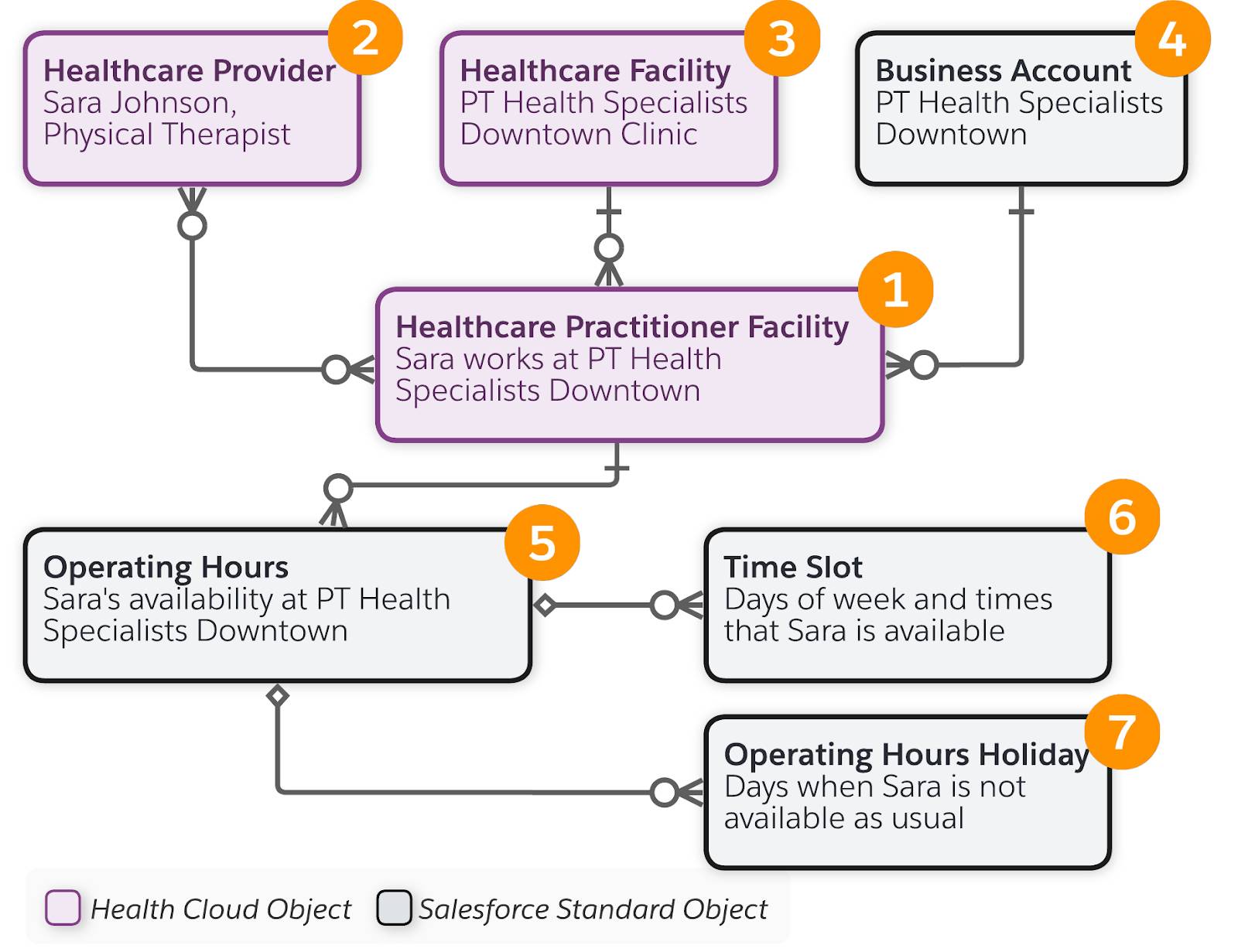
Here’s a summary of the objects and records.
Scenario Details |
Object and Record Details |
|---|---|
Sara works at the PT Health Specialists Downtown branch. |
Healthcare Practitioner Facility The healthcare practitioner facility record (1) references:
|
Sara works from 9 AM to 5 PM on Mondays, Wednesdays, and Fridays. |
Operating Hours (5) represents the hours that a person or organization is available to work. An operating hours record references time slot (6) and operating hours holiday (7) records. Time Slot (6) represents a range of time on a specified day of the week during which Sara performs her work. Operating hours consist of one or more time slot records. |
Sara is not available on national holidays in the US such as Memorial Day and Labor Day. |
Operating Hours Holiday (7) represents the days that Sara is not available at the usual time; for example, on national holidays. |
If Charles Green searches for a physical therapist at this point, he knows that Sara is available in a facility close to him on specific days. But how does he know if Sara is in the Bloomington Health Plans PPO network?
Healthcare Payer and Facility Networks
To represent the payer network that a healthcare provider is affiliated with, two objects come into play: Healthcare Facility Network and Healthcare Payer Network.
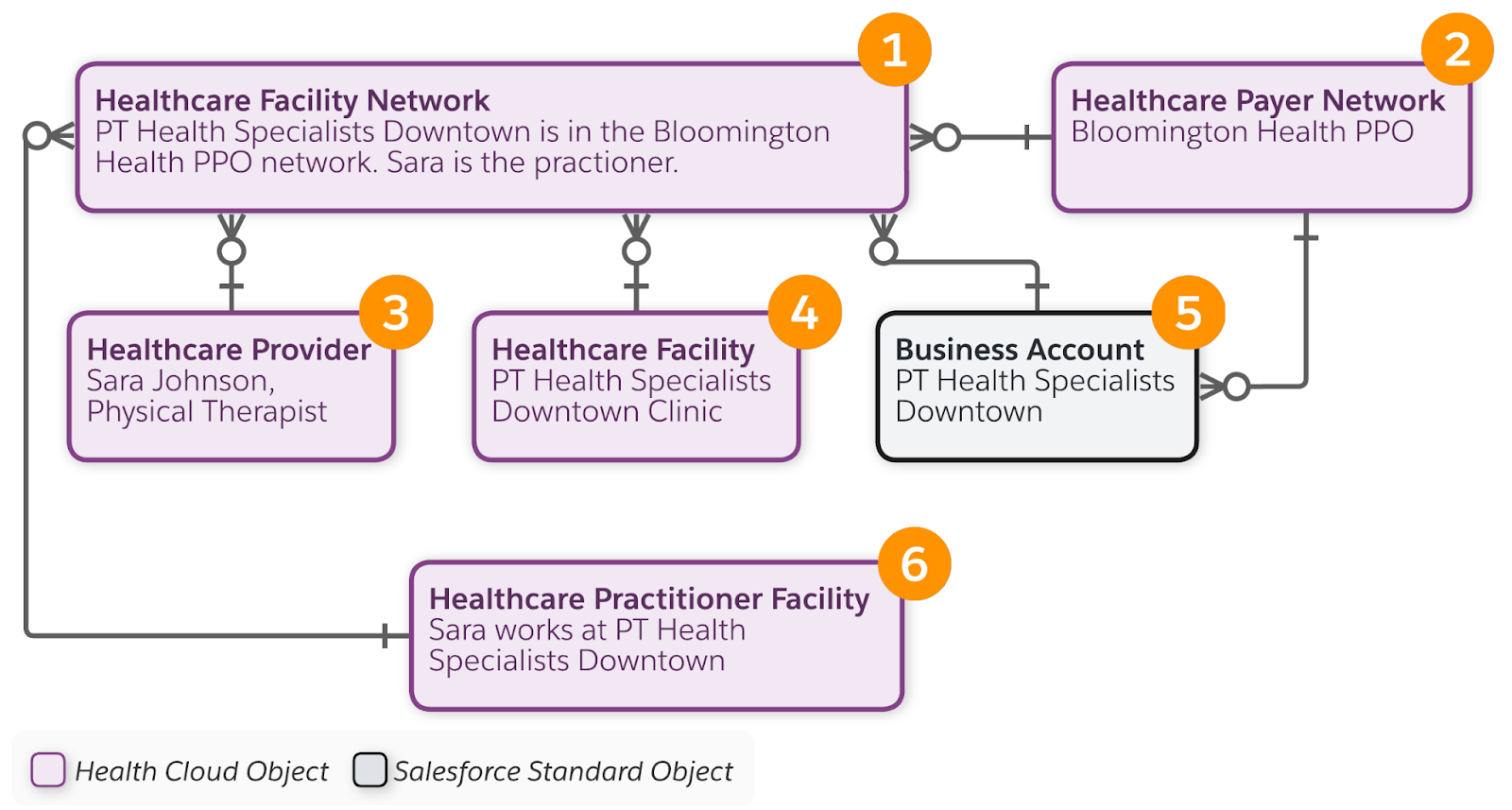
Here’s a summary of the objects and records.
Scenario Details |
Object and Record Details |
|---|---|
PT Health Specialists Downtown and Sara are in the Bloomington Health Plans PPO payer network. |
Healthcare Facility Network (1) identifies the payer network that a location or business entity is a part of. A healthcare facility network record references:
|
Bloomington Health Plans is the insurer that provides a PPO option for the network. |
Healthcare Payer Network (2) represents an insurance network group. This object includes the type of network, such as HMO, PPO, or EPO. |
Now when Charles Green searches for a provider, he sees that Sara Johnson is a physical therapist who is available in a nearby location and in his network. However, how can Charles be sure she specializes in the type of physical therapy he needs for his ailment? Let’s see how to represent Sara’s healthcare specialties next.
Healthcare Provider Specialties
A healthcare provider can have multiple specialties and subspecialties. To represent them, Health Cloud has several care specialty objects.
Sara specializes in orthopedic physical therapy.
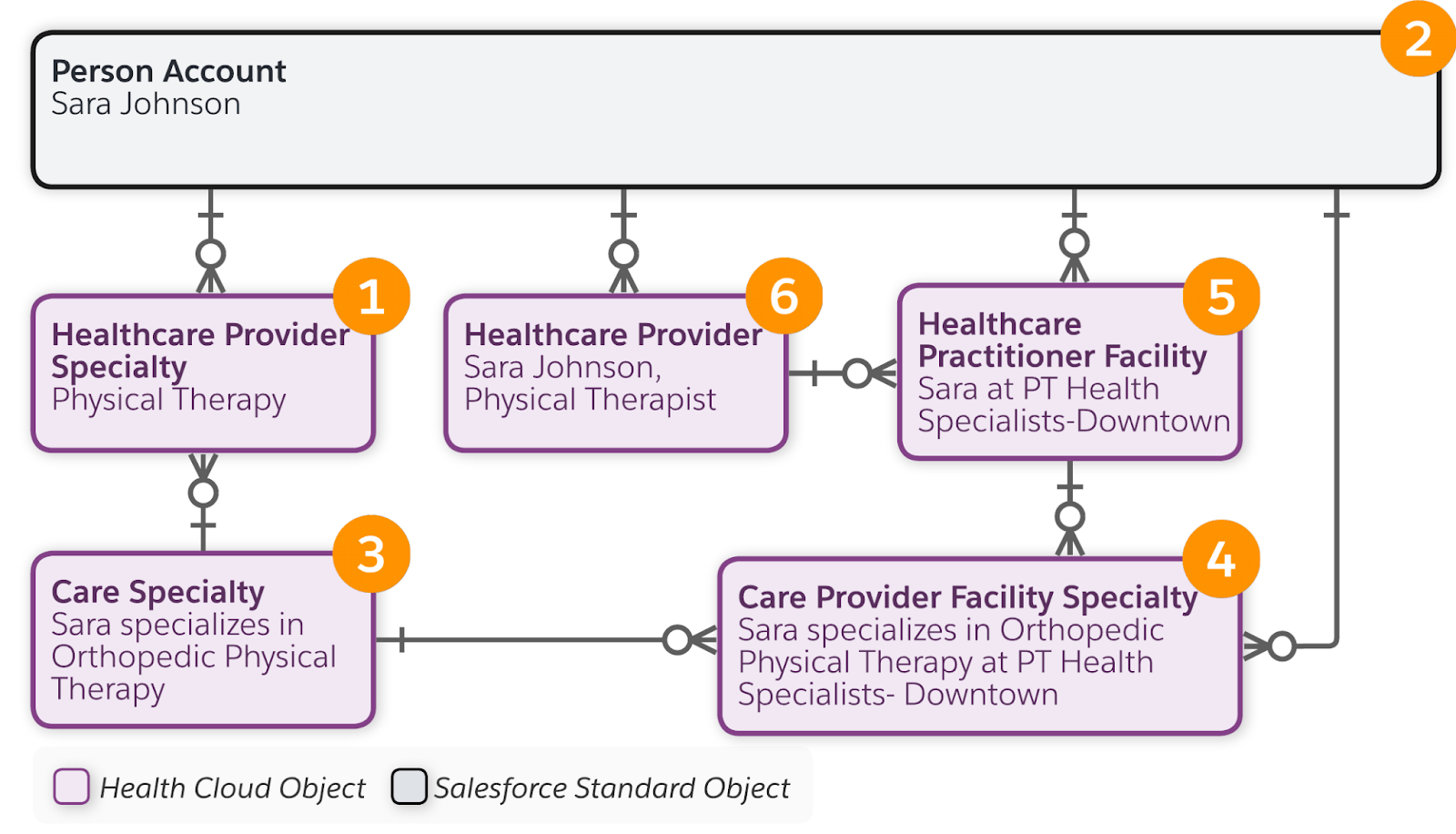
Here’s a summary of the objects and records.
Scenario Details |
Object and Record Details |
|---|---|
Sara specializes in orthopedic physical therapy. |
Healthcare Provider Specialty (1) represents specialties for a practitioner or a provider organization. Sara specializes in orthopedic physical therapy but she may have other specialties such as oncology or neurology physical therapy, each of which require different records. Sara’s healthcare provider specialty record references:
Care Specialty (3) stores provider specialty codes and descriptions. |
Sara specializes in orthopedic physical therapy at PH Health Specialists Downtown. |
Care Provider Facility Specialty (4) represents all the specialties that the practitioner provides at a given location. Sara specializes in orthopedic physical therapy at PH Health Specialists Downtown but she may specialize in oncological physical therapy on different days at this facility. Therefore, she may have two care provider facility specialty records related to PT Health Specialists Downtown. Sara’s care provider facility specialty record references:
|
Next, let’s see how to represent that Sara is formally qualified with these healthcare specialties.
Healthcare Provider Certification, Education, and Licenses
Health Cloud has objects that represent a practitioner’s certifications, education, and licenses. These objects relate to either or both of the Person Account and Healthcare Provider objects.
Sara has a National Provider Identifier (NPI) number, a business license, awards and credentials, including her American Board of Physical Therapy Specialties certification.
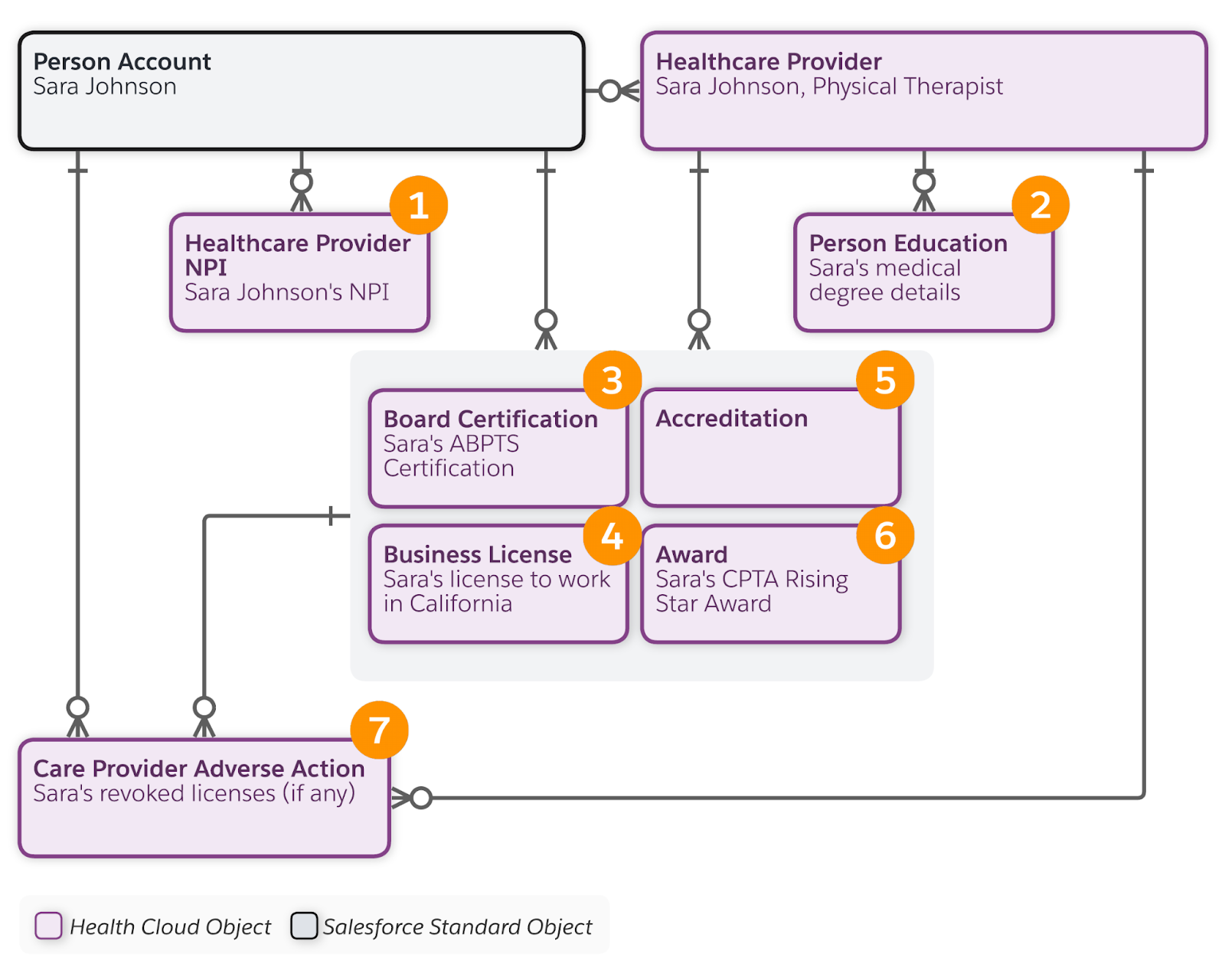
Here’s a summary of the objects and records. Unless otherwise stated, records reference both the person account and the healthcare provider records.
Scenario Details |
Object and Record Details |
|---|---|
Sara has a National Provider Identifier (NPI). |
Healthcare Provider NPI (1) represents the National Provider Identifier assigned to every facility and licensed practitioner in the United States. Sara’s NPI record references her person account record. |
Sara has a medical degree. |
Person Education (2) stores professional education details for a person in a provider role. Sara’s education record references her healthcare provider record. |
Sara is a board-certified Clinical Specialist in Orthopaedic Physical Therapy. |
Board Certification (3) stores a practitioner's board certifications, which demonstrate the practitioner has undergone extra training to become a specialist or learn the latest advancements in their speciality. |
Sara has a business license to work in California. |
Business License (4) stores the licenses of a party role like healthcare provider or producer. |
Not Applicable to this scenario. |
Accreditation (5) represents the professional accreditations of a facility. For example, a joint commission accredits a facility as a general acute care hospital. |
Sara is a recent winner of the California Physical Therapist Association (CPTA) Rising Star award. |
Award (6) stores a person's or organization's professional awards. |
Sara doesn’t have a record of any revoked licenses or other disciplinary actions. |
Care Provider Adverse Action (7) captures adverse actions against the provider, such as malpractice lawsuits or revoked licenses. |
For more details about the objects we introduced in this unit, see the Salesforce Health Cloud Developer Guide.
The next unit wraps up our tour of Healthcare data models with a look at the objects in the Utilization Management data model.
Resources
- Salesforce Help: Provider Network Management
- Trailhead: Provider Network Management with Health Cloud
